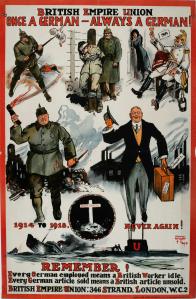War Art Piece 1 – Once a German – Always a German
-
What aspect of war, or event, does this piece of art depict?
The poster, distributed by the British Empire Union with the headline “Once a German, always a German” depicts the opposite roles played by the Germans during the war. On the one hand you have the charming side of the Germans who were always looking to make a dea), which is illustrated by showing a well-dressed German businessman of the day, and on the other hand you have the ruthlessness and hostility of the Germans which is illustrated by showing wartime actions of German soldiers killing children and adults and that of a German U-boat sinking the Lusitania, a British cruise ship.
- Who created this piece of art?
The poster was created by the British Empire Union; as a result it shows how the British soldiers are assuming what the German were like. It was also is a recruiting tool to get more British soldier to fight in Europe.
- Where was this piece of art created?
This poster was created in the United Kingdom in the city London. The poster even included the address of the organization that made it, at 346 Strand, a street in the portion of greater London called Westminster.
- For what purpose was this art created?
This piece was created notify the British public to not hire any German citizens because they would be taking away jobs from local people in Britain, and to boycott purchasing any German produced goods as well. The poster shows some of the brutal events that german soldiers had done during the war, and that they should not support the German economy.
- What does this piece of art tell us about the experience of war?
This propaganda image clearly depicts the stereotypes and prejudices that the British Empire had against all German people. It also gives us an idea about the economic situation during the war. The poster discourages subjects of the British Empire from purchasing German goods or hiring German people. The poster illustrates the atrocities of war with the image of a German bayoneting a baby, and also the death of a nurse. It portrays Germans as violent and vicious people.
- How accurate is this depiction of war?
In order for one to truly deem this picture, “an accurate depiction of war”, one must have experienced war. However, for the sake of the assignment, it can be argued that this is not an accurate depiction of war. The image of the German solider standing over a woman with an impaled baby is not accurate. Rather, the image is used to create extreme anger in the British people towards the Germans. Furthermore, it is not likely that German soldiers enjoyed killing captured soldiers as the picture suggests. Moreover, suggesting that all German generals were alcoholic pigs that raped women is also inaccurate. The poster suggests that all Germans were terrible people and capable of evil, with a disregard for innocence, which of course was not true. This picture is not an accurate depiction of war, however, is an accurate depiction of the power of propaganda.
- How does this piece of art further our understanding of Canadian history?
The poster illustrates the tensions that existed between the Britain and Germany at the time, and how past aggressive and hostile actions by the Germans were viewed by the British. Given that Canada was a British colony at the time, it’s likely that Canadians shared these same views as the British.

Leave a comment
Comments 0